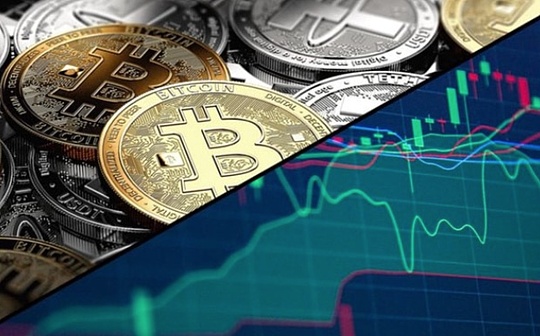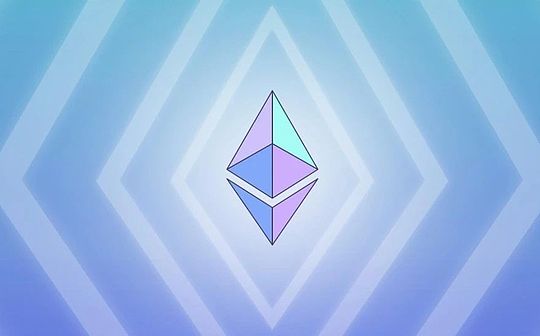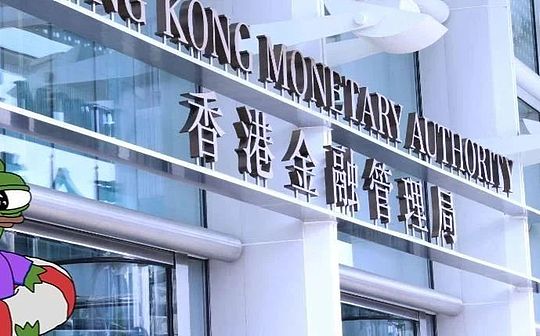
Author: Zhao Qirui, Lynne
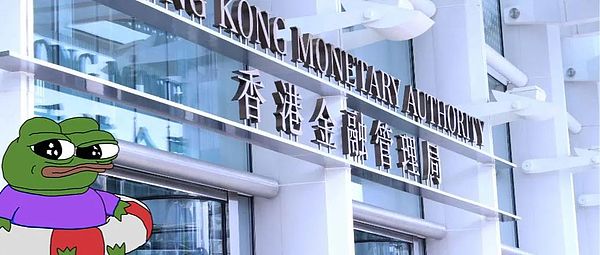
“The digital asset regulatory framework built by Hong Kong and its leading sandbox use case practices clearly present the specific path for how innovation can achieve steady development within the compliance framework. As stated in the Hong Kong Digital Asset Development Policy Declaration 2.0, Hong Kong is constantly building a “trusted and innovative digital asset ecosystem” and will continue to consolidate its leading position in the global digital asset field and promote Hong Kong to become a global innovation center.”
1. The development history of Hong Kong’s digital assets
1.1 Overture: The “pause button” in the mainland and the “fast forward button” in the world (2017-2022)
In 2017, mainland China adopted a policy of comprehensively stopping the virtual asset market, pressing the “pause button” for the development of digital assets.In September of that year, seven ministries and commissions of China jointly issued the “Announcement on Preventing the Risk of Token Issuance and Financing”, which completely stopped the initial token issuance (ICO) activities and closed all virtual currency trading platforms in the country, aiming to effectively clear market risks.Since then, the mainland has further strengthened its crackdown on “disguised trading” and “over-the-counter trading”, and in September 2021, it was clearly characterized by all business related to virtual currency (including transactions, redemption, intermediary, advertising, etc.) as illegal financial activities.This series of high-pressure regulatory measures effectively maintain the stability and risk controllability of the financial system.
Of courseAnd, this strict“Chaining” has inadvertently become a “catalyst” for the global crypto industry, triggering a wave of “going overseas” for talents, capital and projects.A large number of Web3 entrepreneurs, technical teams and funds who were originally active in the mainland have begun to seek overseas compliance development space.Accelerate the sowing and expansion of Web3 concepts worldwide.
While the mainland implements strict supervision, Hong Kong’s role is more prudent and subtle.It is not only a “firewall” to avoid risk spillovers, but also quietly becomes a “observation post” to observe the development of global Web3.In order to encourage financial technology innovation while protecting the interests of investors, the Hong Kong Monetary Authority took the lead in launching the “Financial Technology Regulatory Sandbox” in September 2016. Subsequently, the SFC and the Insurance Regulatory Authority (HKIA) also launched their respective sandboxes, and upgraded to “Sandbox 2.0” in 2017 to achieve cross-sector coordinated operations.In September of the same year, the Hong Kong Securities and Futures Commission (SFC) issued a statement on ICO for the first time, pointing out that if the token has the “securities” attribute, it may be regulated by the Securities and Futures Ordinance, emphasizing the regulatory principle of “substantive over form”.Since then, SFC has continued to focus on the operations of virtual asset fund managers and trading platforms, and launched the FinTech Regulatory Sandbox in 2018, allowing companies to test their FinTech innovation projects, including businesses related to virtual assets, in a controlled environment.
At the application level, the Hong Kong government is actively exploring the practical application of blockchain technology.For example, in 2020, four blockchain pilot projects were completed, covering government services such as trademark transfer, environmental impact assessment, traceability of pharmaceutical products, and company document archives and records, to explore the feasibility and benefits of blockchain technology application.In June 2022, the government further launched the “Shared Blockchain Platform” and plans to develop more general services and reference program modules to assist various policy bureaus/departments in developing more blockchain applications.
In addition, Hong Kong is also actively exploring the tokenization of central bank digital currency (CBDC) and real-world assets (RWA).The Hong Kong Monetary Authority launched the research on the “Cybersecurity Hong Kong Dollar” project in June 2021 and released the “Crypto Assets and Stablecoin Discussion Document” in January 2022, proposing the concept of a stablecoin regulatory framework.The Hong Kong Monetary Authority and the Hong Kong Center under the Innovation Hub of the Bank of International Settlement Bank jointly completed the “Project Genesis” project in 2021, aiming to experiment with issuing tokenized green bonds in Hong Kong.In 2022, the Hong Kong government also personally participated in the Hong Kong FinTech Week’s NFT issuance pilot program, aiming to test the technological benefits brought by virtual assets.
During this period, it is hard not to remind people of why Hong Kong, which is firmly standing with the Chinese people, has prepared and studied the regulatory framework of virtual assets in a low-key manner while the mainland is strictly supervising?Although it started relatively slowly in policy, it has laid the foundation for a more active layout in the future with its profound heritage as an international financial center, strong foundation of the traditional financial industry and professional financial service capabilities.
1.2 The key to the chess game: Hong Kong’s “making moves” and strategic intentions (2023-2025)
From the end of 2022 to 2023, Hong Kong’s digital asset regulatory policy ushered in a landmark turning point, which is seen as Hong Kong’s key “making move” in this global digital economy strategic game.On October 31, 2022, the Hong Kong Special Administrative Region Government issued the “Policy Declaration on the Development of Hong Kong’s Virtual Assets”, which clearly stated for the first time that it would “actively promote” the development of virtual assets ecologically, marking the shift of regulatory thinking from “risk-oriented” to “opportunity-oriented”.Immediately afterwards, on December 7, 2022, the “2022 Combating Money Laundering and Terrorist Funding (Amendment) Bill” was approved by the Hong Kong Legislative Council, and a mandatory licensing system for Virtual Asset Service Providers (VASP).The system came into effect on June 1, 2023, allowing licensed virtual asset trading platforms (VATPs) to provide services to retail investors on the premise of complying with strict investor protection measures.Since then, Hong Kong has further approved virtual asset spot ETFs, making it the largest virtual asset ETF market in the Asia-Pacific region.As of June 2025, SFC has officially issued licenses to 10 VATPs, and another 11 institutions are applying.In addition, the Hong Kong SAR Government also designated the Stable Coin Ordinance to be officially implemented on August 1, 2025, further improving the regulatory framework for digital assets.
Choose “open the door” at this time, and the author interprets it as a national level.High-riseStrategic choice.After a round of wild growth and risk exposure (such as FTX, LUNA, etc.), the market’s demand for compliance, transparency and trust has become unprecedentedly strong.At this time, Hong Kong is the “bridgehead” and represents China entering the market in a “compliant” and “controllable” model, collecting global digital asset resources and competing for the next generation of financial technology’s voice, which is undoubtedly the best time tomachine.Hong Kong’s unique “one country, two systems” framework enables it to balance the mission of the international financial center with the considerations of mainland financial security.Hong Kong Monetary Authority President Yu Weiwen pointed out that the ordinance establishes a “risk-based, pragmatic and flexible regulatory environment” and provides healthy, responsible and sustainable development conditions for Hong Kong’s stablecoins and the broader digital asset ecosystem.Its goal is to significantly enhance its attractiveness to global Web3 talents, funds and projects with a complete regulatory architecture and ecosystem.To empower the real economy, provide new impetus for economic development.This will move Hong Kong from a traditional international financial center to a world-leading digital asset innovation center, and consolidate its strategic position as a bridgehead and a “super contact” for the internationalization of the RMB.Hong Kong Financial Secretary Chan Mo-po emphasized that Hong Kong’s attitude towards Web3.0 is not just about regulation, but about achieving a balance to ensure market integrity while not killing innovation.
Hong Kong’s “first-first-try” policy has also been actively linked and echoed by mainland cities, indicating a potential model of “Hong Kong pilot and mainland linkage”.Mode.For example, Ant Digital has listed Hong Kong as its overseas headquarters and has successfully passed the regulatory sandbox test.Its RWA (real-world asset) tokenization practice has been verified. For example, Langxin Group and Ant Digital Technology cooperated with Ant Digital Technology to complete the first RWA project based on new energy physical assets in China, and GCL Energy and Ant Digital Technology to complete the RWA based on photovoltaic physical assets. These projects were announced through the Ensemble project sandbox of the Hong Kong Monetary Authority.These cases show that Hong Kong’s regulatory clarity and international openness are providing an important channel for mainland companies to participate in the global digital asset market under the premise of compliance.A report released by Zeng Shengjun, the Greater Bay Area Finance Institute of the Shenzhen Branch of Bank of China, and Guan Zhenqiu, the Hong Kong Finance Institute of Bank of China, believes that the experience of Hong Kong’s stablecoin pilot can be summarized and research on offshore RMB-linked stablecoins can be strengthened.In addition, the Hong Kong SAR government itself has also played a leading role, such as issuing NFTs in 2022, and then became the first region in the country to issue tokenized government green bonds in 2023, and issued the second batch of tokenized government green bonds in 2024.This strategic collaboration not only promotes the development of Hong Kong’s digital asset ecosystem, but also builds a new bridge for the connection between the mainland and the international capital market.
2. Hong Kong Digital Assets “Twin Peaks Supervision” Framework
Hong Kong’s digital asset supervision system is characterized by its “Twin Peaks” model as its core feature. The Hong Kong Securities and Futures Commission (SFC) and the Hong Kong Financial Authority (HKMA) have divided the work and collaborated to jointly build a regulatory environment that encourages financial innovation and strictly adheres to the bottom line of risks.The essence of this model lies in the clear division of powers and responsibilities: SFC focuses on the “investment” attributes of virtual assets, while HKMA focuses on its “payment” function.The following table will systematically clarify the functions, legal basis, jurisdiction and regulatory tone of the two major regulatory agencies, providing a clear guide to understanding Hong Kong’s regulatory blueprint.
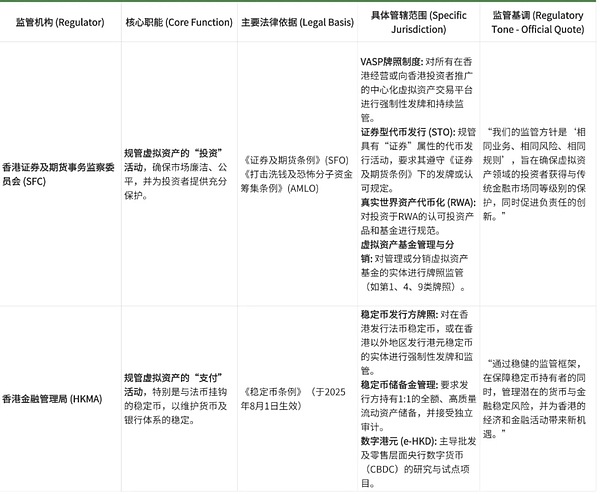
Table: Comparison of rights and responsibilities of core regulatory agencies
Hong Kong SFC and HKMA have formed a coordinated and complementary regulatory structure through clear functional division and close cooperation (such as signing a memorandum of understanding)..As the guardian of the securities market, SFC extends the mature investor protection principle to the field of virtual asset investment; while HKMA, as the center of the financial system, ensures that the innovation of payment tokens will not shake Hong Kong’s monetary foundation.This model of dual peaks and clear rights and responsibilities together constitutes a solid institutional guarantee for Hong Kong to develop into a world-leading virtual asset center.
3. VASP license and stablecoin issuanceCore analysis of regulatory
Hong Kong’s virtual asset supervision framework consists of two pillars: the virtual asset service provider (VASP) license system and stablecoin issuance supervision.This section will provide an in-depth interpretation of the key points and regulatory logic of these two frameworks.
3.1 VASP license system: demarcate red lines for trading platforms
The VASP license system, which will come into effect on June 1, 2023, is the core of Hong Kong’s regulation of virtual asset transactions.This system requires that all centralized virtual asset trading platforms (VATPs) operating in Hong Kong or developing their businesses with Hong Kong investors must be licensed regardless of whether they trade securities tokens.This move aims to incorporate all relevant platforms into a unified and strict regulatory system.
1. Investor protection: informed, understand insurance, affordable
To protect retail investors, regulators have set multiple thresholds.Before opening an account for retail customers, the platform must evaluate its level of knowledge about virtual assets and conduct sufficient risk disclosure.When recommending a transaction, the platform also needs to ensure that the recommendation is in line with the customer’s personal circumstances.The logic behind it is very clear: ensure that investors are “informed, understood, and affordable” before entering the market, and avoid unnecessary losses caused by information asymmetry.In addition, the CSRC also reserves the right to set investment ceilings for high-risk virtual assets, adding another line of defense to the financial security of retail investors.
2. Customer asset safety and financial stability
In view of the lessons learned by platforms such as FTX collapsed due to abuse of customer funds, Hong Kong has set the world’s top strict standards for customer asset security.
-
Asset “hard isolation”:The core requirement is that the platform must hand over the customer’s virtual assets to an independent third-party custodian (usually a Hong Kong licensed trust company) and follow the industry best practices of 98% cold storage and 2% hot storage. This move is designed to minimize the possibility of the platform misappropriation of assets.The client’s fiat currency must also be stored in a separate trust or designated account.
-
High financial threshold:The platform must not only have paid-in capital of no less than HK$5 million and liquid capital of HK$3 million, but also must reserve liquid assets that are sufficient to cover at least 12 months of operating expenses.This ensures that the platform has the ability to resist market risks and continue to operate, and avoids damaging investors’ interests due to its own financial problems.In addition, the platform also needs to purchase insurance approved by the China Securities Regulatory Commission for customer assets.
3. Anti-money laundering/anti-terrorist financing (AML/CFT)
The anonymity and cross-border characteristics of virtual assets make them prone to becoming a breeding ground for illegal activities.Therefore, VASP license requires the platform to strictly implement AML/CFT measures such as “Know Your Customer” (KYC), Customer Due Diligence (CDD).This includes continuously monitoring transactions, reporting suspicious activity, and encouraging the use of blockchain analytics tools to improve tracking capabilities.These regulations are designed to enhance transaction transparency, combat financial crimes, and safeguard Hong Kong’s reputation as an international financial center and the integrity of its financial system.
4. Token listing and trading scope
To control risks from the source, the platform must establish an independent token review committee.The committee is responsible for conducting rigorous due diligence on all tokens planned to be listed, evaluating their legitimacy, security, team background and even technical foundations.Regulation clearly stipulates that only high liquidity tokens that are non-security and included in mainstream indexes can be opened to retail investors.This prudent screening mechanism aims to protect investors (especially retail investors) from inferior or fraudulent projects and ensure fairness and transparency in the market.
5. Prohibit business activities
To ensure the neutrality of the platform, VATP is prohibited from conducting self-operated transactions for its own accounts. The core purpose is to prevent conflicts of interest between the platform and its customers.In addition, current guidelines still prohibit platforms from issuing or trading virtual asset futures and related derivatives.This reflects the cautious attitude of regulators when facing complex and high-risk products, and gives priority to ensuring market stability.The CSRC said it will review it in due course in the future and consider the possibility of opening up such products to institutional investors.
3.2 Stablecoin regulatory framework: Establish regulations for “quasi-currency”
Stablecoin regulation is a key step in Hong Kong’s global virtual asset center, led by the Hong Kong Monetary Authority (HKMA).The relevant draft regulations were adopted on May 21, 2025 and will officially come into effect on August 1 of the same year.
1. Focus on fiat currency pegged stablecoins
The core goal of the regulatory framework is to “specified stablecoins” pegged to one or more fiat currencies, because such assets have payment potential and their stability is directly related to financial security.Based on the lessons learned from the Terra/LUNA collapse, algorithmic stablecoins that lack physical asset support are explicitly excluded from regulation.It is worth noting that the regulation has extraterritorial effect: no matter where the issuer is, as long as the Hong Kong dollar stablecoin issued reaches Hong Kong users, it must comply with Hong Kong license regulations.
2. Ensure that the word “stability” is true
To issue stablecoins in Hong Kong, the issuer must obtain a HKMA license.The core requirements revolve around “stability” and “trustworthiness”:
-
1:1 full reserve:100% reserve support must be provided with high-quality liquid assets.
-
Transparentletter:Reserves must undergo regular third-party audits and be disclosed to the public.
-
Stable operation:A reliable redemption mechanism, strict AML/CFT measures and plans to ensure network security and business continuity must be established.
These high threshold requirements are designed to ensure that stablecoins can be redeemed at any time, preventing the risk of “deaning” and thus building market confidence.
3. Start prudently and encourage innovation
HKMA will adopt an extremely cautious attitude in the early stages of license issuance, and it is expected to issue only a small number of licenses, and requires applicants to prove that their stablecoins have clear and real application scenarios.
Hong Kong has established a “sandbox” mechanism to allow intentional institutions to test their business models and risk control capabilities in a controlled environment.This “prudent licensing + sandbox trial” strategy aims to ensure that the first batch of licensed institutions have a benchmark role, while providing valuable practical experience for supervision and the market, and ultimately promote the compliant application of stablecoins in payments, cross-border remittances and other fields, and consolidate Hong Kong’s financial innovation position.In the latter chapter, we will continue to analyze how this mechanism works.
4. From the perspective of the applicantWatch the panoramic process of supervision sandbox
Hong Kong’s core strategy in the field of virtual asset supervision is its carefully designed “regulatory sandbox” mechanism. This is not only a regulatory tool, but also a strategic platform to promote the development of the financial technology ecosystem, aiming to seek a balance between embracing financial technology innovation and maintaining financial stability and protecting investors.Hong Kong’s “regulatory sandbox” is essentially a “dialogue mechanism between regulation and innovation” and a “testing ground for risk isolation”.
This process is not a simple license application, but a long, rigorous and in-depth interaction of “co-evolution” journey.It puts extremely high requirements on applicants’ capital, technology, compliance capabilities and risk management level.
allDesign of a processReflecting the Hong Kong regulatory authoritiesRigorous, interactive and penetrating.
1. Prepare to be King (application stage):The focus of this stage is on the internal “fine crafting”.HKMA expects applicants to complete the highly mature business model design, technical system construction and compliance framework construction before formal submission.This actually puts most of the preparations in advance, ensuring that the entry into the sandbox is well prepared, high-quality participants.
2. In-depth interaction (testing stage):sandThe box is far from a passive observation period, but a “laboratory” where supervision and innovation collide and evolve together.By appointing “case officials”, establishing a “chat room” mechanism, and requiring continuous data sharing and reporting, HKMA has been able to gain an in-depth understanding of the actual operating risks of innovative businesses, and enterprises can also timely adjust and optimize their plans under the guidance of supervision to reduce the risk of ultimate non-compliance.
3. High-standard graduation (assessment stage):The threshold for “graduation” is extremely high, and the evaluation standards directly point to the core of financial stability – reserves, redemption mechanisms, risk control systems and technical security.From the design of “principle approval (AIP)” to the “formal license”, the last insurance is set up for the final market access to ensure that all the promised capital and systems are fully in place.
This rigorous process is not a simple regulatory checkpoint, it also builds an ecosystem of mutual benefit and win-win results between regulatory agencies and innovative enterprises.The actual effect it produces is two-way, which is reflected in the following two aspects:
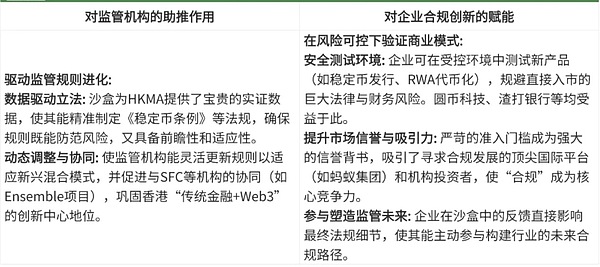
In short, Hong Kong’s regulatory sandbox mechanism, especially path design for stablecoin issuers, is the most strategic and visionary component of its digital asset regulatory framework.It goes beyond the traditional one-dimensional model of approval and creatively integrates the two seemingly opposite concepts of “strict supervision” and “frontier innovation”.
Through this carefully designed process, Hong Kong not only sets the world’s leading compliance standards for the market, but also establishes a dynamic, self-optimized regulatory and industrial interaction ecosystem.This is not only escorting its own financial stability, but also announcing to the world that Hong Kong has the ability and wisdom to control the future of digital finance, and is committed to becoming the safest, most standardized and most dynamic hub in the global virtual asset field.This “two-way empowerment” sandbox is the cornerstone of Hong Kong’s global digital finance leadership.In the fifth part of the article, we will enter the sandbox to analyze this dynamic interactive process.
5. Regulatory Sandbox——Typical cases under the path to compliance
This chapter analyzes the practical cases of Hong Kong’s regulatory sandbox in the digital asset field, reveals the core considerations from the regulatory perspective, and tries to grasp the “development pulse” of Hong Kong in embracing the process of web3 innovation.
5.1 Stablecoin Regulatory Sandbox: Be pragmatic first and solve pain points
In July 2023, the Hong Kong Monetary Authority conducted consultations on legislative suggestions on implementing the stablecoin issuer regulatory system and announced the launch of a sandbox arrangement.In July 2024, the HKMA announced the first list of participants entering the sandbox, includingJD Coin Chain Technology (Hong Kong),Yuanbi Technology, and byStandard Chartered Bank (Hong Kong), Ansu Group and Hong Kong TelecomA joint composed ofCombination.The first batch of three companies are countedThe first issuance of stablecoins pegged to the Hong Kong dollar.
-
JD Coin Chain Technology (Hong Kong):According to Liu Peng, JD.com Coin Chain, its stablecoin project (JD-HKD) mainly focuses onCross-border payments,Invest in transactionsandRetail paymentThree practical use scenarios.Expand users in cross-border payment scenarios through direct customer acquisition and non-direct customer acquisition (such as cooperating with compliant wholesalers), and expand investment and trading customers with global compliance exchanges.In terms of retail payment, it was first launched at JD Global Shopping Hong Kong and Macau Station, so that users can take the lead in using stablecoins to pay bills in JD Hong Kong and Macau e-commerce business in JD Hong Kong and Macau.In terms of specific strategies, JD will “tailor” the stablecoin payment plan for different industries, and at the same time, combining JD’s international logistics scenarios, it will put data such as order warehouses of small and medium-sized enterprises overseas on the chain to improve the payment and financing efficiency of enterprises.It is reported that JD.com’s JD.com’s JD.com currency chain has registered “JCOIN” and “JOYCOIN”, and the market generally believes that these two names will be used as their stablecoins.
-
Yuanbi Technology:As a company founded by former President of the Hong Kong Monetary Authority Chen Delin, Yuanbi Technology will soon launch the HKD stablecoin HKDR, which is mainly aimed at three major business scenarios:Cross-border trade, virtual asset trading and RWA.Relying on the SVF licenses obtained by its parent company, as well as shareholders and partners such as HashKey Exchange, Cobo Digital Asset Custodian, Lianlian Payment, etc.The foundation and channels accumulated in the fields of web3, custody, payment and transaction, Through the advantages of ecological collaboration, Yuanbi Technology is expected to lay out the full link of web3 ecological payment and realize the seamless connection between web2 and web3.
-
Standard Chartered Bank, Amptomatic Group and Hong Kong Telecommunications Union:As a practitioner in the native web3 field, Aiming Group is responsible for the development of native web3 application scenarios. Standard Chartered Bank is a Hong Kong dollar issuing bank to drive bank customer resources. Hong Kong Telecom has an electronic payment program Tap&Go, focusing on the contact of retail customers.Through joint application, the three parties have achieved the maximization of stablecoin promotion, large-scale circulation and application, and achieved full coverage of traditional banking customers, traditional payment customers and web3 users.In terms of application scenarios, it includes virtual asset trading in web3 games, cross-border trade and financial settlement in traditional finance, etc.
It is worth noting that on July 23, Hong Kong Monetary Authority President Yu Weiwen once again stated that many of the dozens of institutions that are interested in applying for stablecoin licenses have lacked practical application scenarios, practical and practical specific plans and implementation plans, let alone the awareness and ability to control risks.Some institutions that can provide application scenarios lack the technology to issue stablecoins and the experience and ability to control financial risks.It is recommended that it does not need to become the issuing entity, but cooperates with the issuing party to provide application scenarios.Overall, the HKMA will only approve several stablecoin licenses, which “may disappoint many applicants.”
The author believes that from the current stablecoin issuers entering the box, the HKMA has the following three considerations for stablecoin issuers:First, focus on whether the issuer has real application scenarios, especially in the real economy services fields such as cross-border trade, e-commerce, and finance, can we use the advantages of stablecoin technology to improve payment efficiency and other financial conveniences in transactions?Second, whether you have the awareness and ability of financial risk management, able to ensure the establishment of appropriate investor protection measures.Third, control the overall number of deals, avoid financial risks and waste of competitive resources caused by the lack of the first two necessary prerequisites.
5.2 Ensemble Sandbox: Innovate financial market infrastructure and promote tokenized applications
In March 2024, the Hong Kong Monetary Authority announced the launch of the Ensemble project toPromote the use of wholesale central bank digital currency (wCBDC) for interbank tokenized deposit settlement, and use tokenized currency for tokenized asset transactions.In May of the same year, the Ensemble Project Architecture Working Group was established to jointly establish standards and make suggestions with the industry to promote interoperability between wCBDC, tokenized currencies and tokenized assets.In August, the Hong Kong Monetary Authority announced the first phase of the Ensemble project and introduced the four major tokenization theme use cases, includingFixed income and investment funds, liquidity management, green and sustainable finance, and trade and supply chain financing.
Hong Kong Securities Regulatory Commission CEO Leung Fengyi said,The “Ensemble” project is a project to build a key architecture, which will promote the scale of the tokenized ecosystem in a new stage of development and is the core of Hong Kong’s innovative financial infrastructure facilities..Tokenization of central bank currency and bank deposits at the wholesale level will inject strong impetus into the overall tokenization project.Tokenized currencies and deposits are the prerequisites for fully unleashing the potential of tokenization.
In the past year, the Ensemble project has successively announced many use cases, and this chapter will select key points to introduce them.
1. Green and sustainable finance
Ant Digital Family is greenand sustainable finance and tradeYihe Supply Chain Finance is an important participant in two key areas, and has implemented multiple use cases.In addition to the three use exceptions of Ant Digital Technology cooperation, China Resources Longde’s “Charge Meihao” electric vehicle charging station tokenization case was also selected as the Hong Kong Ensemble project, and its business model is similar to that of Langxin Technology.This section is developed with three use cases of Ant Digital Cooperation.
-
Charging pile industryRWA (with Langxinscience and technologycooperate):Langxin Technology is a leading energy technology company in China, and has developed a number of energy digital products and new energy Internet platforms.For example:Life payment platform that cooperates with Alipay and other portals, providing more than 450 million meter users with “inquiry, payment, bills, bills” online services for public utilities such as water, electricity, heat, etc.;Xinyao Photovoltaic Cloud Platform, operated through distributed photovoltaic platforms, widely connect various power stations, and aggregate margins to the Internet;Its new energy aggregate charging platform – Xindun, build a charging “AI digital hub” to link the demand for new energy vehicles with over 2 million charging equipment.It can be seen that Langxin is not a new energy enterprise that uses digital technology to transform in the traditional sense, but an industrial digital technology solution supplier with digital technology as its core competitiveness, that is, a “technology and service provider focusing on business information systems in the public utility field.”
The first charging pile industry RWA has raised funds of RMB 100 million.Langxin Group uses some charging piles operated on the Xindun platform as supporting assets, and issues “charging piles” digital assets on the blockchain based on trusted data. Each digital asset represents part of the income rights of the corresponding charging piles.Among them, the Ant Chain inside product module provides data on-chain technical support.Local and small and medium-sized charging stations connected to the new power route face similar financing difficulties for small and medium-sized enterprises, such as low credit for the entity and difficulty in bank financing, but they also have the advantages of being familiar with local resources, market expansion and flexible operating models.Through the linking of equipment operation data, the project is expected to provide construction and operation support for thousands of small and medium-sized energy storage and charging pile operators on the platform, and helpAssist energy storage, charging operators and other energySource enterprises revitalize existing high-quality assets.
-
PhotovoltaicindustryRWA (cooperation with GCL):Ant Digital Technology further collaborated with GCL Energy Technology to successfully complete the RWA based on photovoltaic entity assets, involving an amount of more than 200 million yuan.The “Xinyangguang” brand under Xinxin Energy Technology, based on household photovoltaic business, carries out a complete business system including product research and development, marketing sales, engineering construction, functional operation and maintenance of household photovoltaic systems.GCL Energy Technology will use the “Xinyangguang” household photovoltaics located in Hubei Province and Hunan Province as RWA support assets. Through the combination of blockchain technology and loT technology, it will package and store data such as the value, operation, and income of the household photovoltaic project on the blockchain to form a digital token.
-
Two-wheeled battery swap business RWA (cooperation with Xunying Group):About 4,000 battery-powered vehicle battery replacement cabinets and 16,000 lithium batteries nationwide operated by Anhui Xunying New Energy Group will be issued to the private equity market with 20 million yuan in financing.Combining loT and blockchain technology, the value, operation, income and other data of the battery swap project are stored on the blockchain to form digital tokens to revitalize existing assets and accelerate capital recovery, while enhancing the liquidity and transaction of battery swap assets.easysex.
Through the three new energy RWA cases jointly developed by Ant Digital Technology, we can see some common features:
One isCompared with operating assets such as agricultural products, real estate, restaurant operations, etc. that require human intervention, the new energy industry’s charging and swapping assets have the inherent advantages of being connected to the power supply and the network. They can operate and upload data independently without personnel intervention, which excludes the situation where some comments believe that “hiring 100,000 yuan of cleaning aunt wipes equipment for a month” is used as operating expenses, which harms investors’ rights and interests.
Second,Compared with the direct financing of the underlying assets with large companies as financing entities and indirect financing methods as credit entities, RWA financing is in the form of projects (all of which are large-scale (millions) small and medium-sized new energy operation terminal equipment in the above cases), providing new solutions to small and medium-sized enterprise financing (or a collective of small and medium-sized enterprises or operators), providing support for overseas funds to support the development of the domestic new energy industry.
Third,Ant Digital Technology provides a number of technologies to protect investors’ rights and interests.For example: loT technology ensures real-time connection of assets, instantly tracks device operation dynamics, AI improves operational efficiency, asset data is on the chain, and ensures the real and reliable data, etc., and finally synchronizes the detailed data of new energy operators’ charging device ID, charging device status, charging amount, charging amount, charging time and other detailed data with multiple parties, so that the assets and returns are transparent and visible.
According to the above cases, it also provides new ideas and inspiration for the potential underlying assets of subsequent RWA products.Stock assets with four major characteristics: network management, local operation, power supply and network connection, and direct revenue generation, have significant potential to become RWA-backed assets in the future.For example, local shared rental equipment (children’s cars and scooters that are self-service rental in shopping malls), smart unmanned retail machines, income rights for industrial rental equipment, smart parking income rights, edge computing node computing power service rental income rights, etc.
2. Trade and supply chain financing
There are many international trade documents involved in cross-border trade. A trans-ocean transportation may require 50 pages of documents and 30 relevant parties. The sea bill of lading, which is an important property rights certificate, carries the function of ensuring the delivery of goods to the consignee on the final bill of lading.However, at present, shipping bills of lading still mainly relies on traditional paper methods to transfer, and the proportion of electronic bills of lading in 2024 is less than 4%.In 2018, COSCO Shipping initiated the establishment of the Global Shipping Commercial Network Platform (GBSN). GBSN was registered and established in Hong Kong in 2021, and launched its first “paperless delivery” product in July of the same year.In June 2022, the first blockchain electronic bill of lading based on the GSBN platform, IQAX eBL, was approved and recognized by the International Insurance Compensation Group.
Electronic bill of lading (eBL):Ant Digital Technology assists the Financial Administration to build a tokenized asset platform in the sandbox to promote silver-to-customer deal (DvP) transactions between traditional assets and tokenized deposits, so that electronic bills of lading (eBL) issued by the Global Shipping Business Network (GSBN) can be tokenized transactions on the platform.And HSBC, Hang Seng Bank and Bank of China (Hong Kong) have promoted the use of tokenized deposits to settle the transfer of electronic bills of lading.The solution significantly improves the efficiency of trade processes, enhances the security of data and transactions, and opens up new ways to resolve trade financing gaps.
3. Fixed Income and Investment Funds
Fixed income and investment funds focus on the tokenization of bonds and funds.In the bond market,Hong Kong has passed EvergreenHubExplore the tokenization of green bonds:
-
In February 2023, the Hong Kong SAR government announced that it would successfully issue HK$800 million tokenized green bonds under the green bond program, which is also the first tokenized green bonds issued by the government in the world.This bond first-level issuance is used on a private blockchain network to settle securities tokens representing the actual equity of the bonds and cash tokens representing the HKD fiat currency bonds in the HKMA in a T+1 currency (DvP).Settlement is provided by the Central Settlement System of Debt Instruments (CMU), Goldman Sachs’ tokenization platform GS DAPTM is responsible for the delivery.Subsequent bond processes (including coupon payment, secondary market transaction settlement and maturity redemption) will also be carried out in digital form on the private chain network.
-
In February 2024, the Hong Kong Special Administrative Region Government announced the successful sale of digital green bonds denominated in Hong Kong, Hong Kong dollars, Hong Kong dollars and euros with a total value of approximately HK$6 billion under the Hong Kong government green debt plan.The settlement and settlement system used by this batch of digital green bonds is the CMU and HSBC Orion digital asset platforms, and is also the first batch of multi-currency digital bonds in the world.
-
passThe settlement procedure for unified bond issuance or fund trading generally takes 2-5 working days, while tokenized bonds and funds support 7*24 hours of timely payment andKnotCalculation can significantly shorten the time required, while simplifying the transaction process, eliminating delivery delays, and reducing correspondingrisk.
-
202In August 4, at the Ensemble sandbox launch ceremony, Li Dazhi, vice president of the Hong Kong Monetary Authority, said that the issuance of bonds verified in the sandbox is to verify the end-to-end transaction process, which is technically different from previous tokenized bonds.The development of tokenized finance does not happen overnight, and needs to be verified at different technical levels.It can be inferred from this that the focus of the early issuance test is on the issuance and settlement process on the blockchain network and digital asset platform. In the later stage, it will verify that the bonds flow between a wider range of different entities, thereby verifying that tokenized green bonds can achieve 7*24-hour transaction related.technology.
Money market funds,HSBC and BOC Hong Kong were among the first participants under the topic.According to the disclosures of the two banks,Currently, the feasibility of tokenizing deposits and financial assets, trading between tokenized deposits and tokenized assets, as well as transferring deposit tokens to blockchains in different financial institutions has been realized.
This use case better reflects how Ensemble promotes the tokenized conversion and transaction of traditional financial assets between banks and builds new financial market infrastructure.The following figure shows the specific process, where the thick arrows indicate the new technologies and trading channels tested in the sandbox.
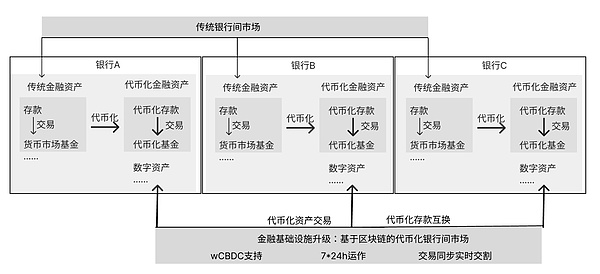
Figure: Ensemble Sandbox supports the tokenization of financial assets and the construction of new infrastructure
4. Liquidity Management
Liquidity management focuses on repurchase agreements and treasury management use cases, and promotes banks to build tokenized deposit-based corporate treasury management solutions for customers.In May 2025, HSBC’s tokenized deposit infrastructure was put into use and launched the first blockchain settlement service provided by banks in Hong Kong.Ant International is the first corporate customer to adopt this solution. After the deposits of its HSBC account have been tokenized, it issued instructions to HSBC to transfer the tokenized deposit transactions through its internal fund management platform Whale, successfully completing the instant internal fund allocation.By leveraging the characteristics of programmable and instant delivery of tokenized deposits, tokenized funds management solutions are expected to improve more transparent, efficient and convenient corporate payment and fund management solutions.
6. Future prospects
The digital asset regulatory framework established by Hong Kong and its leading sandbox use case practices clearly present the specific path of how innovation can achieve stable development within the compliance framework.As stated in the “Hong Kong Digital Asset Development Policy Declaration 2.0”, Hong Kong is constantly building a “trusted and innovative digital asset ecosystem” and will continue to consolidate its leading position in the global digital asset field and promote Hong Kong to become a global innovation center.
With the formal implementation of the “Stablecoin Ordinance” on August 1, it also provides a more solid institutional foundation and broad development space for Hong Kong to promote stablecoin application scenarios, expand the types of tokenized products, and improve the liquidity and popularity of stablecoins and tokenized financial products.
Looking ahead, relying on the deep foundation of traditional international financial centers, the first-mover advantage of the systematic regulatory framework in the digital asset field, and the natural hub connecting the mainland and the global digital asset market, Hong Kong is expected to leap to become a key node of global digital assets and a core hub for real-world asset tokenization, building an unreplicable unique competitiveness.




